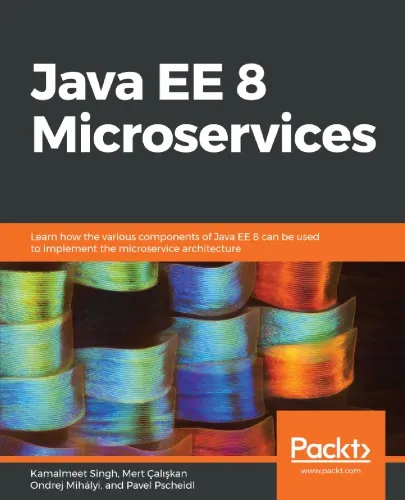Java EE 8 Microservices - Learn how the various components of Java EE 8 can be used to implement the microservice architecture.
4.2
Reviews from our users

You Can Ask your questions from this book's AI after Login
Each download or ask from book AI costs 2 points. To earn more free points, please visit the Points Guide Page and complete some valuable actions.Analytical Summary
"Java EE 8 Microservices - Learn how the various components of Java EE 8 can be used to implement the microservice architecture" is a technical and practical exploration of how enterprise developers, architects, and academics can harness the power of Java EE 8 to build scalable, resilient, and maintainable microservices.
The book navigates through core Java EE 8 technologies—such as JAX-RS for RESTful endpoints, JSON-B and JSON-P for data serialization, CDI for dependency management, and JPA for database interaction—in the context of microservice design. The approach is not merely theoretical; it walks the reader through real-world application patterns, deployment scenarios, and integration strategies aligning with contemporary cloud-native trends.
With microservices becoming increasingly predominant in enterprise architecture, Java EE 8 offers a standardized, stable platform to implement these patterns. This book not only dissects the individual components but also addresses cross-cutting concerns such as service discovery, configuration management, fault tolerance, and security. It situates Java EE 8 within the broader ecosystem and clarifies its role compared to alternatives, bridging traditional enterprise techniques with a modern microservices mindset.
Information unavailable on the exact publication year or specific awards due to no reliable public source, but the relevance of this work continues despite such missing details as it aligns with ongoing needs in enterprise-level software development.
Key Takeaways
Readers will acquire both a conceptual framework and actionable skills for building microservices using Java EE 8 technologies.
First, the intricate capabilities of Java EE 8 modules are contextualized for distributed architectures, showing their strength in delivering cohesive yet loosely coupled services.
Second, the book emphasizes best practices around microservice architecture: modularization, API design, testing strategies, and deployment considerations.
Third, it offers practical insights into solving typical microservice challenges, including data consistency, inter-service communication, and scaling across infrastructure.
Fourth, readers will see how Java EE 8 microservices integrate with modern tooling—Docker, Kubernetes, CI/CD pipelines—offering a bridge to the broader DevOps landscape.
Finally, it reminds us that successful microservice projects depend equally on technical competence and organizational readiness, ensuring that technology adoption aligns with team capabilities and strategic goals.
Memorable Quotes
Microservices are about scaling teams as much as scaling applications.Unknown
Java EE 8’s maturity brings stability to the otherwise volatile world of microservice frameworks.Unknown
The art of building microservices lies in balancing autonomy with cohesion.Unknown
Why This Book Matters
This book provides clarity amid the complexity of modern architectures by presenting Java EE 8 as a reliable foundation for microservices.
For professionals entrenched in legacy enterprise systems, the transition to microservices can be daunting. By focusing on Java EE 8’s well-established capabilities, the book demystifies this evolution, offering both strategic perspective and hands-on techniques.
In the academic space, it bridges theoretical design with pragmatic application, making it suitable for coursework and professional reference alike.
For development teams, the systematic exploration of cross-cutting concerns ensures that service implementation remains secure, sustainable, and performant over time.
Inspiring Conclusion
"Java EE 8 Microservices - Learn how the various components of Java EE 8 can be used to implement the microservice architecture" stands as a definitive resource for anyone determined to master the interplay between enterprise-grade robustness and microservice agility.
By synthesizing deep technical insights with industry realities, it empowers readers to take the leap from monolithic architectures to high-performing, distributed systems. Whether for self-study, team training, or organizational transformation, this guide invites you to not just read, but apply, share, and discuss its principles within your professional network.
Your next step: engage with the patterns, experiment with examples, and evolve your architectural practices—making Java EE 8 microservices the backbone of your next successful project.
Free Direct Download
You Can Download this book after Login
Accessing books through legal platforms and public libraries not only supports the rights of authors and publishers but also contributes to the sustainability of reading culture. Before downloading, please take a moment to consider these options.
Find this book on other platforms:
WorldCat helps you find books in libraries worldwide.
See ratings, reviews, and discussions on Goodreads.
Find and buy rare or used books on AbeBooks.
1006
بازدید4.2
امتیاز50
نظر98%
رضایتReviews:
4.2
Based on 0 users review
"کیفیت چاپ عالی بود، خیلی راضیام"
Questions & Answers
Ask questions about this book or help others by answering
No questions yet. Be the first to ask!


